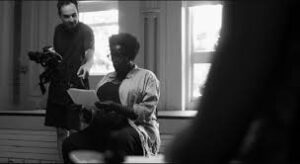By Valerie Milano
Los Angeles, CA (The Hollywood Times) 10/20/2024 – In a world that often overlooks the unique struggles faced by individuals on the autism spectrum, Spectrum emerges as a poignant exploration of courage, resilience, and the human spirit. The film follows Steve, portrayed by Director Rick Stanton’s brother, as he navigates the complexities of daily life with autism, and the nuance required to navigate it. Audiences are invited to witness not only the challenges Steve confronts but also the profound potential for greatness that lies within him and every person, including friends and family that fall within the spectrum.
 To truly understand and advocate for individuals on the autism spectrum, one must appreciate the realities of their daily experiences. Director Rick Stanton brings a unique perspective shaped by his lifelong relationship with his brother, Steve. Stanton recalls, “I shared a room with Steve, my brother, until I was 24 in a small castle-flat in East London, so I very much have a shared, lived experience of him growing from childhood to adulthood. The way he has gone through life, I wanted to show that when something is difficult for him it may not always be obvious because it’s internal, it’s just like all of us. Being on the spectrum doesn’t necessarily mean that it’s an outward disability. That’s what we wanted to give the audience, the experience of when something is challenging for somebody with autism.”
To truly understand and advocate for individuals on the autism spectrum, one must appreciate the realities of their daily experiences. Director Rick Stanton brings a unique perspective shaped by his lifelong relationship with his brother, Steve. Stanton recalls, “I shared a room with Steve, my brother, until I was 24 in a small castle-flat in East London, so I very much have a shared, lived experience of him growing from childhood to adulthood. The way he has gone through life, I wanted to show that when something is difficult for him it may not always be obvious because it’s internal, it’s just like all of us. Being on the spectrum doesn’t necessarily mean that it’s an outward disability. That’s what we wanted to give the audience, the experience of when something is challenging for somebody with autism.”
Click below for our exclusive interview:
Spectrum offers viewers a richly layered perspective that transcends the characters’ challenges, showcasing a unique directorial approach that prioritizes authenticity. To honor the story’s integrity, Stanton cast individuals on the spectrum, all of whom had no prior acting experience. Stanton reveals, “When writing this, it wasn’t about how to direct someone who has never acted before, it was about leaning into their strengths. For example, there are alot of comic book references in the film, and that’s because one of Steve’s friends Kyle, he’s an encyclopedia of comic books. So, it was like okay let’s draw from Kyle’s natural ability of knowing so many reference points, and let’s just dive into that to use his strengths.”

He continues, remembering the method behind each scene filmed, “None of the cast who never acted before, the cast with autism, none of them ever read any of the script. Basically, I wrote the script, I had what we needed to begin shooting, but I would only ever give the scenario for the scene and nothing more. For example, I would say, in this scene you need to try and convince your friend that they should wear a suit for a job interview, and that would be basically what I tell them. No rehearsal, just straight-away shooting. What started happening though, is that things began to unfold as we went, and we started to lean into things that came up naturally. After about 4-5 takes, we would get these golden nuggets that would let us know we were on the right track. I knew where to push the scene in terms of the natural dialogue and we have to try to keep it on the track of the story.”
By employing an innovative directing style that embraces authenticity and spontaneity, Rick Stanton invites viewers to engage with the story on a deeply personal level. The film not only highlights the internal challenges faced by individuals like Steve but also celebrates their strengths and unique perspectives. As audiences connect with the characters, they are reminded of the immense potential that resides within everyone, urging a broader understanding and acceptance of neurodiversity. Ultimately, Spectrum champions the message that true advocacy begins with empathy, illuminating the richness of life that can be found in every person’s journey.





